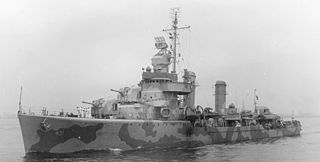
USS Kephart (DE-207/APD-61) was a Buckley-class destroyer escort in service with the United States Navy from 1944 to 1947. After spending 20 years in reserve, she was transferred to Republic of Korea Navy and served another 18 years as Kyong Puk (PF-82) until she was struck in 1985.

USS Plunkett (DD-431), a Gleaves-class destroyer, is the only ship of the United States Navy to be named for Rear Admiral Charles Peshall Plunkett.

USS Rodman (DD-456/DMS-21), a Gleaves-class destroyer, is the first ship of the United States Navy to be named for Admiral Hugh Rodman.

USS Mervine (DD-489/DMS-31), a Gleaves-class destroyer, was the second ship of the United States Navy to be named for Rear Admiral William Mervine, who served during the War of 1812, the Mexican–American War and the American Civil War. Mervine was laid down on 3 November 1941 by the Federal Shipbuilding & Dry Dock Company of Kearny, New Jersey and launched on 3 May 1942, sponsored by Miss Mildred Mervine great-granddaughter of the admiral. The ship was commissioned on 17 June 1942, with Lieutenant Commander S. D. Willingham in command.

USS McCook (DD-496), a Gleaves-class destroyer, was the second ship of the United States Navy to be named for Commander Roderick S. McCook (1839–1886), who was an officer in the Union Navy during the American Civil War.

USS Finch (DE-328) was an Edsall-class destroyer escort in the service of the United States Navy from 1943 to 1946 and from 1956 to 1969. From 1951 to 1954, she was loaned to the United States Coast Guard where she served as USCGC Finch (WDE-428). She was scrapped in 1974.

USS Bates (DE-68/APD-47) was a Buckley-class destroyer escort in service with the United States Navy from 1943 to 1945. She sank after being hit by three kamikaze on 25 May 1945.

USS Marsh (DE-699) was a Buckley-class destroyer escort of the United States Navy.

USS Daniel T. Griffin (DE-54/APD-38), a Buckley-class destroyer escort of the United States Navy, was named in honor of Ordnanceman Daniel T. Griffin (1911–1941), who was killed in action during the Japanese attack on the Hawaiian Islands.

USS George W. Ingram (DE-62/APD-43), a Buckley-class destroyer escort in service with the United States Navy from 1943 to 1947. In 1967, she was transferred to Taiwan. She served as Kang Shan until being scrapped in 1979.

USS Loy (DE-160/APD-56), a Buckley-class destroyer escort in service with the United States Navy from 1943 to 1947. She was converted to high-speed transport (APD) in late 1945. Following her decommissioning, she spent another 19 years in reserve before being sold for scrap in 1966.

USS Parker (DD-604) was a Benson-class destroyer in the United States Navy during World War II. She was the second ship named for Foxhall A. Parker, Jr..

USS Enright (DE-216/APD-66) was a Buckley-class destroyer escort in service with the United States Navy from 1943 to 1946. In 1967, she was transferred to Ecuador where she served until she was scrapped in 1989.

USS Andromeda (AKA-15) was an Andromeda-class attack cargo ship named after the constellation Andromeda. She served as a commissioned ship for 13 years.

USS Staff (AM-114) was an Auk-class minesweeper acquired by the United States Navy for the dangerous task of removing mines from minefields laid in the water to prevent ships from passing.

USS Speed (AM-116) was an Auk-class minesweeper acquired by the United States Navy for the dangerous task of removing mines from minefields laid in the water to prevent ships from passing.

USS Sustain (AM-119) was an Auk-class minesweeper acquired by the United States Navy for the dangerous task of removing mines from minefields laid in the water to prevent ships from passing.

USS Reynolds (DE-42) was an Evarts-class destroyer escort constructed for the United States Navy during World War II. She was sent off into the Pacific Ocean to protect convoys and other ships from Japanese submarines and fighter aircraft. She performed escort and antisubmarine operations in dangerous battle areas and was awarded eight battle stars, a very high number for a ship of her type.

USS Weber (DE-675/APD-75) was a Buckley-class destroyer escort of the United States Navy, named in honor of Ensign Frederick T. Weber (1916–1942), a naval aviator who was posthumously awarded the Navy Cross for heroism during the Battle of Midway.

USS Horace A. Bass (DE-691/APD-124/LPR-124) was a United States Navy high-speed transport in commission from 1944 to 1969.





















